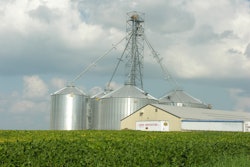After nearly five years of back-and-forth between the grain industry and OSHA over its fluctuating sweep auger policy, a recent agency memo has brought some degree of closure to the issue.
The controversy was sparked in 2008, when an insurance agent wrote to OSHA regarding its policies on whether employees could remove their harnesses and lifeline inside a bin if there were no engulfment hazards present, and if employees could operate sweep augers if the sump was not protected by grating. OSHA’s detailed response cited the Grain Handling Standard (1910.272 (g) (1) (ii), and addressed the sweep auger component by saying it did not intend “a prohibition against employees entering grain storage structures while machinery is running.” But it went on to state that “Employees may enter [grain bins] while machinery is running if the employer can demonstrate that appropriate protection has been provided to prevent employees from being exposed to the hazards/dangers of the moving machinery.”
The response noted the “obvious example” of effective employee protection from hazards through machine guarding, which prompted the insurance agent to follow up with an inquiry about the use ofunguardedsweep augers with employees inside the bin. What followed was OSHA’s infamous series of Letters of Interpretation, stating that unless the employer eliminates all hazards presented by an energized (running) unguarded sweep auger, it was in violation of the Grain Handling Standard.
The problem with this stance is that guarding a sweep auger on all sides, including the front, would render the equipment useless. Sweep augers are used to empty grain from a bin by pulling contents from the outermost area into the middle, where it funnels into a pump and exits underneath the bin onto a conveying system. Sweep augers travel at very low speeds and operation commonly requires a few workers to stay inside the bin to adjust its movement and ensure all the grain reaches the central discharge.
Given that the front of a sweep auger must contact the commodity in order to work properly, many in the grain handling industry were left wondering how they could continue using their equipment without violating OSHA’s policy guidelines.
国家和国有粮食和饲料协会s provided OSHA with feedback over the next few years, expressing the industry’s confusion and frustration over the misguided policy, but in the meantime, OSHA ramped up grain facility inspections and the enforcement of its interpretation letter.
Then, in January 2013, the grain industry reached a milestone victory. A major grain handler in Illinois challenged OSHA after the company was penalized for allowing workers inside their grain bins with energized sweep augers. The company hired Epstein Becker & Green’s national OSHA Practice Group, who proved that a combination of administrative and engineering controls could be used on sweep augers to ensure that no one ever enters the zone of danger while the equipment is operating. As a result, OSHA withdrew all citations and penalties, and the law firm, along with area and regional OSHA directors and administrators, worked together to formulate the “Ten Sweep Auger Safety Principles.” For more detailed descriptions of these principles, go towww.gfai.org/files/news412_Sweep_Auger_Memo_5-3-2013.pdf.
- No employee shall enter a grain bin without a bin entry permit, which confirms there are no engulfment and/or atmospheric hazards present.
- The subfloor auger and the grain entry points must be de-energized and locked out before entering the bin to set up or dig out the sweep auger.
- The grate/guard on the subfloor auger must be in place and secured before operating the sweep auger.
- Employees operating the sweep auger cannot walk on the grain if the depth of the grain presents engulfment hazard.
- The only portion of the sweep auger allowed to be unguarded is the point of operation.
- A rescue-trained and equipped observer must always be positioned outside the storage bin to monitor the activities inside.
- The employer must utilize engineering controls within the grain bin to prevent workers from coming into contact with the energized sweep auger. Acceptable engineering controls include:
- Sweep auger equipped with an attached guard, which prevents the workers contact with the unguarded portion of the auger.
- Sweep auger equipped with a control mechanism, such as a dead-man switch, which will allow for the sweep auger’s operation only when the operator is in contact with the device. The worker must be positioned at least seven feet from the auger at all times it is energized.
- 如果他们温馨的便携式护栏被允许ed at least seven feet behind the sweep auger.
- The auger must be provided with a positive speed control mechanism or bin stop device that prevents the uncontrolled rotation of the sweep auger.
- Workers are prohibited from using their hands or legs to manipulate the sweep auger while it is operating.
- If adjustments are necessary, the sweep must be unplugged, with the person making the adjustments maintaining the control of the plug, or locked-out in accordance with lock-out/tag-out procedures.
OSHA’s next move was another positive for the grain handling industry when it published a long-awaited sweep auger policy memo that stated employers operating sweep augers with the above 10 rules in mind will be considered compliant with the Grain Handling Standard.
When asked about his response to the memo, the Nataional Feed & Grain Association’s (NGFA) director of safety and regulatory affairs, Jess McCluer, said, “I think it’s a step in the right direction that provides some closure on the issues that we had problems with in their interpretation letters. We’re particularly happy to see [OSHA] allowing the use of engineering controls to protect workers because we had advocated for that position since the beginning of this situation.”
According to NGFA outside counsel, the memo can be useful during an inspection to demonstrate a facility has implemented and is following the safety procedures endorsed by OSHA — provided that the inspection is not based on an accident involving employee injury.
Although the memo was generally well-received within the industry, McCluer notes the agency may still have some learning to do about grain handling operations. “The point we’ve been trying to make to OSHA is that sweep augurs have not had a high rate of incidence in the last 30 years.” says McCluer. “There is some confusion within the agency over the difference between sweep augers and floor augers. Floor augers are the type that have a high incidence rate with accidents because if it isn’t properly guarded, or if it’s unguarded, it can cause injuries, but there has never been a high incidence rate regarding sweep augers.”
Despite the minor aspects that still seem misinterpreted by OSHA, its latest memo is a welcome chapter in the sweep auger policy saga.






















